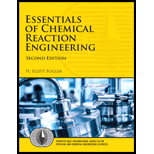
(a)
Interpretation:
The volume of PFR to achieve
Concept Introduction:
Mole balance depends on the law of conservation of mass. To apply it, the boundary of a system must be specified, and the volume enclosed by this boundary is considered for the mole balance. At any point of time, mole balance applied on speciesiis defined by the equation as:
For a Continuous Stirred Tank Reactor (CSTR), the design equation to be used is:
Here,
Here,
For a Plug Flow Reactor (PFR), the design equation to be used is:
Here,
(b)
Interpretation:
The volume necessary for CSTR achieve
Concept Introduction:
Mole balance depends on the law of conservation of mass. To apply it, the boundary of a system must be specified, and the volume enclosed by this boundary is considered for the mole balance. At any point of time, mole balance applied on species iis defined by the equation as:
For a Continuous Stirred Tank Reactor (CSTR), the design equation to be used is:
Here,
Here,
For a Plug Flow Reactor (PFR), the design equation to be used is:
Here,
(c)
Interpretation:
The volume of the second CSTR added to the one in part (b) in series to achieve
Concept Introduction:
Mole balance depends on the law of conservation of mass. To apply it, the boundary of a system must be specified, and the volume enclosed by this boundary is considered for the mole balance. At any point of time, mole balance applied on species iis defined by the equation as:
For a Continuous Stirred Tank Reactor (CSTR), the design equation to be used is:
Here,
Here,
For a Plug Flow Reactor (PFR), the design equation to be used is:
Here,
(d)
Interpretation:
The volume of the second PFR added to the CSTR in part (b) in series to achieve
Concept Introduction:
Mole balance depends on the law of conservation of mass. To apply it, the boundary of a system must be specified, and the volume enclosed by this boundary is considered for the mole balance. At any point of time, mole balance applied on species iis defined by the equation as:
For a Continuous Stirred Tank Reactor (CSTR), the design equation to be used is:
Here,
Here,
For a Plug Flow Reactor (PFR), the design equation to be used is:
Here,
(e)
Interpretation:
The conversion achieved for the given CSTR of volume
Concept Introduction:
Mole balance depends on the law of conservation of mass. To apply it, the boundary of a system must be specified, and the volume enclosed by this boundary is considered for the mole balance. At any point of time, mole balance applied on species iis defined by the equation as:
For a Continuous Stirred Tank Reactor (CSTR), the design equation to be used is:
Here,
Here,
For a Plug Flow Reactor (PFR), the design equation to be used is:
Here,
(f)
Interpretation:
The answers in the above sub-parts are to be analyzed critically.
Concept Introduction:
Mole balance depends on the law of conservation of mass. To apply it, the boundary of a system must be specified, and the volume enclosed by this boundary is considered for the mole balance. At any point of time, mole balance applied on species iis defined by the equation as:
For a Continuous Stirred Tank Reactor (CSTR), the design equation to be used is:
Here,
Here,
For a Plug Flow Reactor (PFR), the design equation to be used is:
Here,
Want to see the full answer?
Check out a sample textbook solution
Chapter 2 Solutions
Essentials of Chemical Reaction Engineering (2nd Edition) (Prentice Hall International Series in the Physical and Chemical Engineering Sciences)
 Introduction to Chemical Engineering Thermodynami...Chemical EngineeringISBN:9781259696527Author:J.M. Smith Termodinamica en ingenieria quimica, Hendrick C Van Ness, Michael Abbott, Mark SwihartPublisher:McGraw-Hill Education
Introduction to Chemical Engineering Thermodynami...Chemical EngineeringISBN:9781259696527Author:J.M. Smith Termodinamica en ingenieria quimica, Hendrick C Van Ness, Michael Abbott, Mark SwihartPublisher:McGraw-Hill Education Elementary Principles of Chemical Processes, Bind...Chemical EngineeringISBN:9781118431221Author:Richard M. Felder, Ronald W. Rousseau, Lisa G. BullardPublisher:WILEY
Elementary Principles of Chemical Processes, Bind...Chemical EngineeringISBN:9781118431221Author:Richard M. Felder, Ronald W. Rousseau, Lisa G. BullardPublisher:WILEY Elements of Chemical Reaction Engineering (5th Ed...Chemical EngineeringISBN:9780133887518Author:H. Scott FoglerPublisher:Prentice Hall
Elements of Chemical Reaction Engineering (5th Ed...Chemical EngineeringISBN:9780133887518Author:H. Scott FoglerPublisher:Prentice Hall
 Industrial Plastics: Theory and ApplicationsChemical EngineeringISBN:9781285061238Author:Lokensgard, ErikPublisher:Delmar Cengage Learning
Industrial Plastics: Theory and ApplicationsChemical EngineeringISBN:9781285061238Author:Lokensgard, ErikPublisher:Delmar Cengage Learning Unit Operations of Chemical EngineeringChemical EngineeringISBN:9780072848236Author:Warren McCabe, Julian C. Smith, Peter HarriottPublisher:McGraw-Hill Companies, The
Unit Operations of Chemical EngineeringChemical EngineeringISBN:9780072848236Author:Warren McCabe, Julian C. Smith, Peter HarriottPublisher:McGraw-Hill Companies, The





